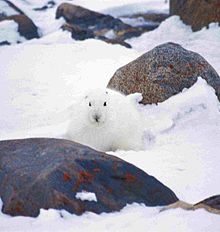Chionophile
This article needs additional citations for verification. (March 2014) |
Chionophiles are any organisms (
Polar regions
Arctic animals
Animals such as
Antarctic animals
Antarctica, also known as the southern pole, is larger and can become much colder than the northern pole. As a result, few animals can survive on the mainland of Antarctica, and those that do mostly live near the coast. The few animals that live on the mainland are
Polar adaptations
Normally when colder conditions arrive, animals go into a state of suspended animation called
Mountainous regions

Other chionophiles can be found on or near the equator and yet still live in freezing temperatures. This is mostly due to their geographical range, such as on high altitude mountains where it can reach very cold temperatures and have less oxygen the higher the altitude. These may include the Andes, the Himalayas and the Hindu Kush mountains, where animals such as
Known chionophiles
This section needs expansion. You can help by adding to it. (July 2018) |
The following animals are known chionophiles:
- ABC Islands bear
- Adélie penguin
- Alaska marmot
- Alaska moose
- Alaska Peninsula brown bear
- Alaskan hare
- Alaskan tundra wolf
- Antarctic fur seal
- Antarctic petrel
- Antarctic tern
- Arctic fox
- Arctic hare
- Arctic redpoll
- Arctic tern
- Arctic warbler
- Arctic wolf
- Atlantic puffin
- Baird's sandpiper
- Baffin Island wolf
- Barnacle goose
- Barren ground shrew
- Barren-ground caribou
- Bearded seal
- Black guillemot
- Black-bellied storm petrel
- Black-legged kittiwake
- Brown skua
- Buff-breasted sandpiper
- Cape petrel
- Chinstrap penguin
- Common murre
- Crabeater seal
- Crested auklet
- Emperor penguin
- Gentoo penguin
- Glaucous gull
- Great skua
- Greater white-fronted goose
- Grey plover
- Grey seal
- Gyrfalcon
- Harbor seal
- Harp seal
- Heuglin's gull
- Hooded seal
- Iceland gull
- Ivory gull
- Kelp gull
- King eider
- Lapland longspur
- Least auklet
- Lemming
- Leopard seal
- Lesser white-fronted goose
- Little auk
- Little stint
- Long-tailed jaeger
- Macaroni penguin
- Muskox
- Nelson's collared lemming
- Northern collared lemming
- Northern elephant seal
- Northern fur seal
- North American brown lemming
- Pacific golden plover
- Parasitic jaeger
- Peary caribou
- Pectoral sandpiper
- Polar bear
- Pomarine jaeger
- Purple sandpiper
- Red knot
- Red phalarope
- Red-legged kittiwake
- Reindeer
- Ribbon seal
- Ringed seal
- Ross seal
- Ross's gull
- Ruddy turnstone
- Sabine's gull
- Sanderling
- Siberian brown lemming
- Snow bunting
- Snow goose
- Snow petrel
- Snowshoe hare
- Snowy owl
- Snowy sheathbill
- South polar skua
- Southern elephant seal
- Southern fulmar
- Spectacled eider
- Spotted seal
- Steller's eider
- Svalbard reindeer
- Thick-billed murre
- Tundra vole
- Ungava collared lemming
- Walrus
- Weddell seal
- White-rumped sandpiper
- Wolverine
- Yellow-billed loon
See also
References
- ^ "Winter: An Ecological Handbook", Page 74, James C. Halfpenny, Roy Ozanne, 1989, Johnson Publishing Company, USA
